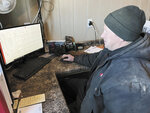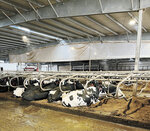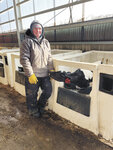


How many times a day do you milk, and what is your current herd average, butterfat and protein? Our cows are currently being milked an average of 2.8 times a day in our robotic milking system. The herd is producing 95 pounds of milk per head per day with 4.2% butterfat and 3.25% protein.
Describe your housing and milking facility. We have a cross-ventilated barn. We milk with four Lely A4 robots and bed our free stalls with recycled manure solids. Our barn has room for all of our dry cows and calves. During the recent cold snap, we were able to maintain the temperature inside the barn at 36 degrees.
Who is part of your farm team, and what are their roles? My wife, Sharon, is in charge of recordkeeping. Our eldest daughter, Pearl, is a registered nurse in Sioux Falls, South Dakota. Our daughter, Krysta, feeds and cares for our calves. Our son, Craig, beds the cows and brings up fetch cows. Our youngest daughter, Dawn, is only 7 years old and is too young to help much.
What is your herd health program? We do pregnancy checks the first week of every month. We dry off late-lactation cows once per week. We vaccinate at dry off and again when the cows are moved into the maternity pen. All of our heifers are given a magnet during their pre-breeding vaccinations.
What does your dry cow and transition program consist of? We dry off our cows at 210-220 days in milk, and they calve at 280 days. About 20 days prior to calving, we move them into a maternity pen that has a bedding pack. After calving, the cows are moved into a fresh pen where they remain for three days. Our dry cow ration consists of grass hay, minerals and corn silage. We add a high-energy pellet along with extra vitamins and minerals to the ration that we feed to the close-up cattle.
What is the composition of your ration, and how has that changed in recent years? Our ration contains alfalfa hay, haylage, corn silage, water and a custom grain mix that we get from our local elevator. The only thing we have changed is buying haylage from our neighbors instead of feeding all dry hay. We have found haylage to be very palatable. Adding haylage to the ration has reduced milk production fluctuations.
Tell us about the forages you plant and detail your harvest strategies. We only have 110 acres, and we plant them all to silage corn. Our goal is to harvest our silage at 66% moisture.
What is your average somatic cell count and how does that affect your production? Our somatic cell count averages between 210,000 and 220,000. It has been somewhat lower, but we didn’t see much of a change in milk production.
What change has created the biggest improvement in your herd average? The consistency of our forages has brought the biggest improvement. Adding haylage to our lactating ration has helped us get the cows dialed in. It’s a constant battle if your forages aren’t consistent.
What technology do you use to monitor your herd? We use the information gathered by the robots and from the activity collars that all of our cows wear.
What is your breeding program, and what role does genetics play in your production level? We have a voluntary waiting period of 60 days. Every month, we breed 15-20 cows to sexed semen, and the rest of the cows are bred to beef bulls. Virgin heifers are bred twice with sexed semen then switched to beef sires. Sharon monitors our herd closely. We will take a heifer off the sexed semen list if Sharon doesn’t think that the heifer’s mother was very good. Using sexed semen has enabled us to be more selective and produce replacement animals from just the top 10%-15% of our herd. Because we milk with robots, we are interested in milking speed. Selective genetics has enabled us to increase milking speed by a full pound per minute.
List three management strategies that have helped you attain your production and component level. The top of the list would be milking our cows with robots. The information that the robots gather has enabled us to make better decisions. Next is adding haylage to our ration, which has helped make our herd’s milk production and milk components more consistent. Third is genetics. We have started to pick out the sires ourselves with an eye toward increasing fat and protein production.
Tell us about your farm and your plans for the dairy in the next year. We built this dairy farm from a blank slate seven years ago. A lot of thought went into the planning, and things have worked out pretty well so far. There are very few items that we would change. Our plans include continuing to improve our herd’s milk production and its levels of milk components.
Comments
No comments on this item Please log in to comment by clicking here